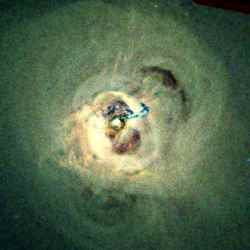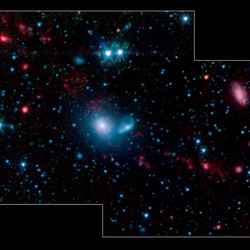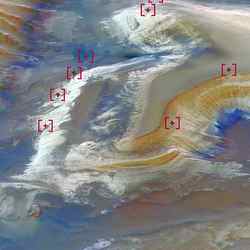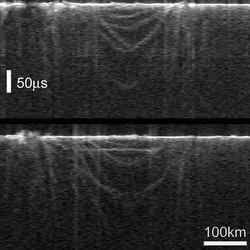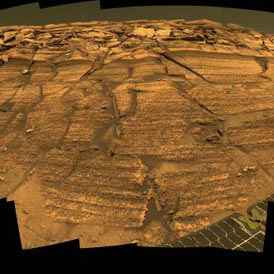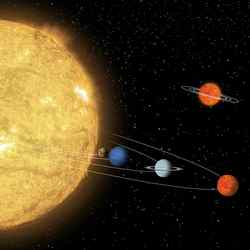
Earth. Image credit: NASA Click to enlarge
The history of life on Earth is closely linked to the appearance of oxygen in the atmosphere. The current scientific consensus holds that significant amounts of oxygen first appeared in Earth’s atmosphere some 2.4 billion years ago, with a second large increase in atmospheric oxygen occurring much later, perhaps around 600 million years ago.
However, new findings by University of Maryland geologists suggest that the second jump in atmospheric oxygen actually may have begun much earlier and occurred more gradually than previously thought. The findings were made possible using a new tool for tracking microbial life in ancient environments developed at Maryland. Funded by the National Science Foundation and NASA, the work appears in the December 2 issue of Science.
Graduate researcher David Johnston, research scientist Boswell Wing and colleagues in the University of Maryland’s department of geology and Earth System Science Interdisciplinary Center led an international team of researchers that used high-precision measurements of a rare sulfur isotope, 33S, to establish that ancient marine microbes known as sulfur disproportionating prokaryotes were widely active almost 500 million years earlier than previously thought.
The intermediate sulfur compounds used by these sulfur disproportionating bacteria are formed by the exposure of sulfide minerals to oxygen gas. Thus, evidence of widespread activity by this type of bacteria has been interpreted by scientists as evidence of increased atmospheric oxygen content.
“These measurements imply that sulfur compound disproportionation was an active part of the sulfur cycle by [1.3 million years ago], and that progressive Earth surface oxygenation may have characterized the [middle Proterozoic],” the authors write.
The Proterozoic is the period in Earth’s history from about 2.4 billion years ago to 545 million years ago.
“The findings also demonstrate that the new 33S-based research method can be used to uniquely track the presence and character of microbial life in ancient environments and provide a glimpse of evolution in action,” said Johnston. “This approach provides a significant new tool in the astrobiological search for early life on Earth and beyond.”
The Air That We Breathe
When our planet formed some 4.5 billion years ago, virtually all the oxygen on Earth was chemically bound to other elements. It was in solid compounds like quartz and other silicate minerals, in liquid compounds like water, and in gaseous compounds like sulfur dioxide and carbon dioxide. Free oxygen — the gas that allows us to breath, and which is essential to all advanced life — was practically non-existent.
Scientists have long thought that appearance of oxygen in the atmosphere was marked by two distinct jumps in oxygen levels. In recent years, researchers have used a method developed by University of Maryland geologist James Farquhar and Maryland colleagues to conclusively determine that significant amounts of oxygen first appeared in Earth’s atmosphere some 2.4 billion years ago. Sometimes referred to as the “Great Oxidation Event,” this increase marks the beginning of the Proterozoic period.
A general scientific consensus has also held that the second major rise in atmospheric oxygen occurred some 600 million years ago, with oxygen rising to near modern levels at that time. Evidence of multicellular animals first appears in the geologic around this time.
“There has been a lot of discussion about whether the second major increase in atmospheric oxygen was quick and stepwise, or slow and progressive,” said Wing. “Our results support the idea that the second rise was progressive and began around 1.3 billion years ago, rather than 0.6 billion years ago.”
In addition to Johnston, Wing’s Maryland co-authors on the Dec. 2 paper are geology colleagues James Farquhar and Jay Kaufman. Their group works to document links between sulfur isotopes and the evolution of Earth’s atmosphere using a combination of field research, laboratory analysis of rock samples, geochemical models, photochemical experiments with sulfur-bearing gases and microbial experiments.
“Active microbial sulfur disproportionation in the Mesoproterozoic” by David T. Johnston, Boswell A. Wing, James Farquhar and Alan J. Kaufman, University of Maryland; Harald Strauss, Universit?t M?nster; Timothy W. Lyons, University of California, Riverside; Linda C. Kah, University of Tennessee; Donald E. Canfield, Southern Denmark University: Science, Dec. 2, 2005.
Original Source: UM News Release

